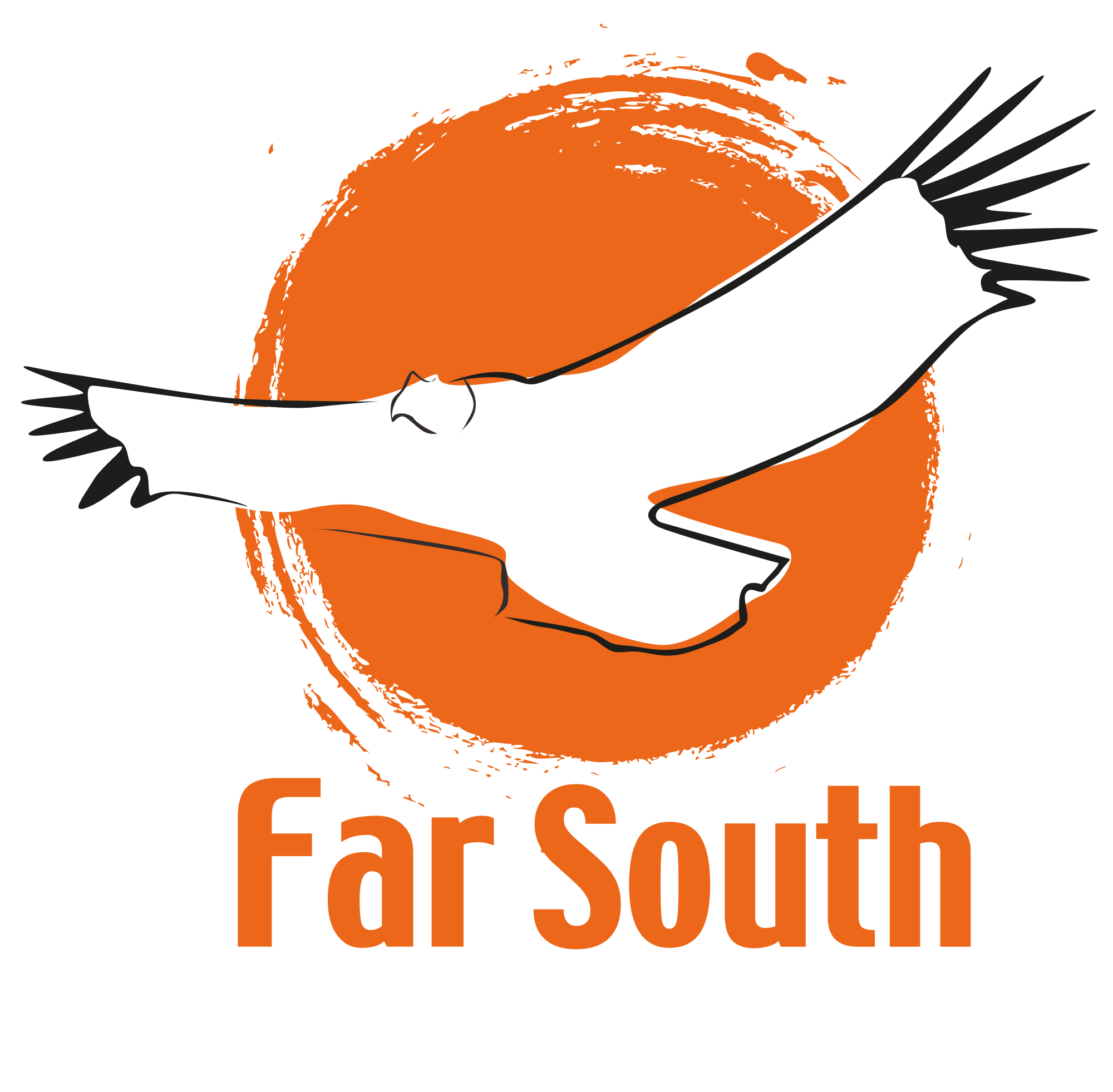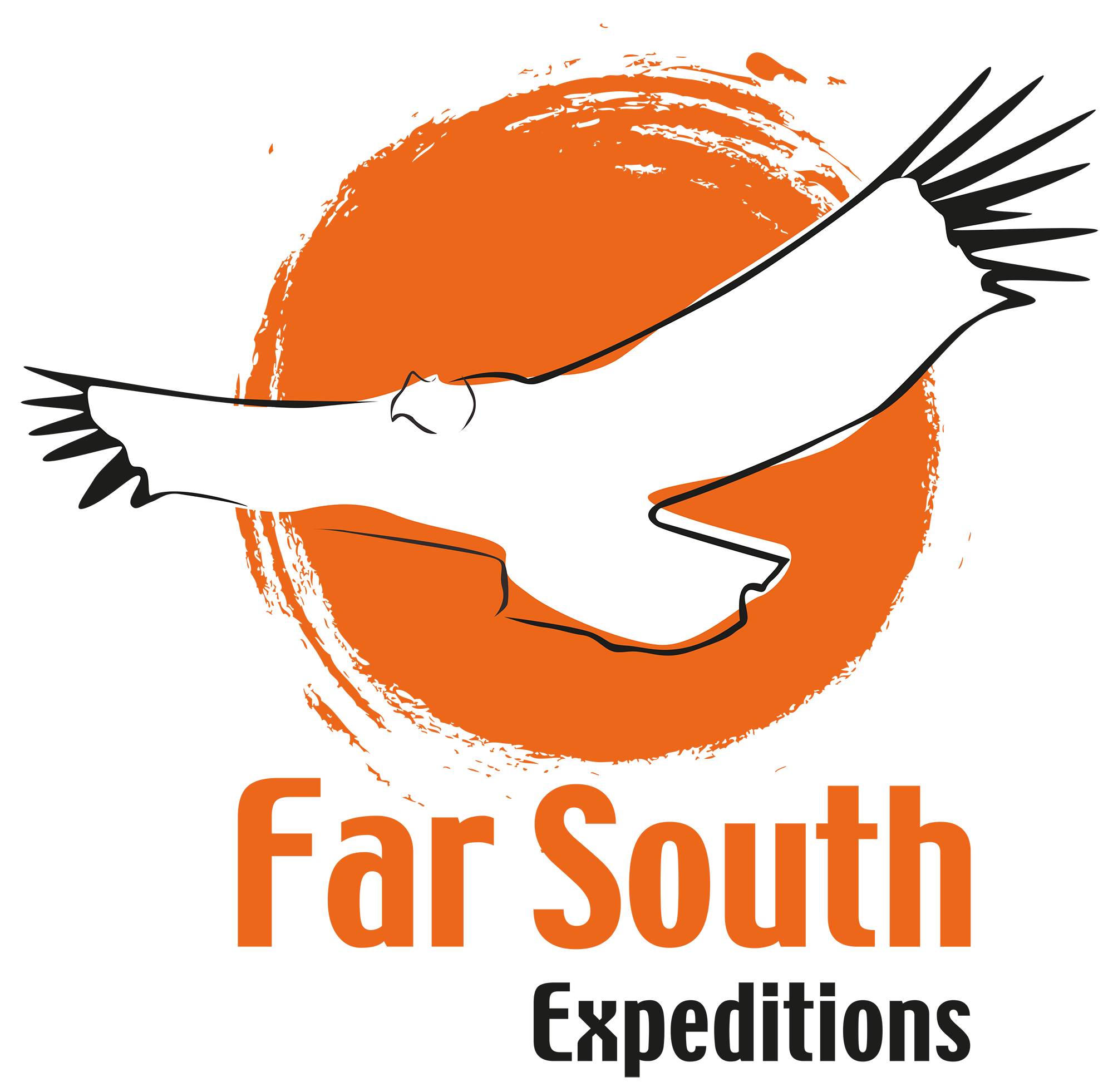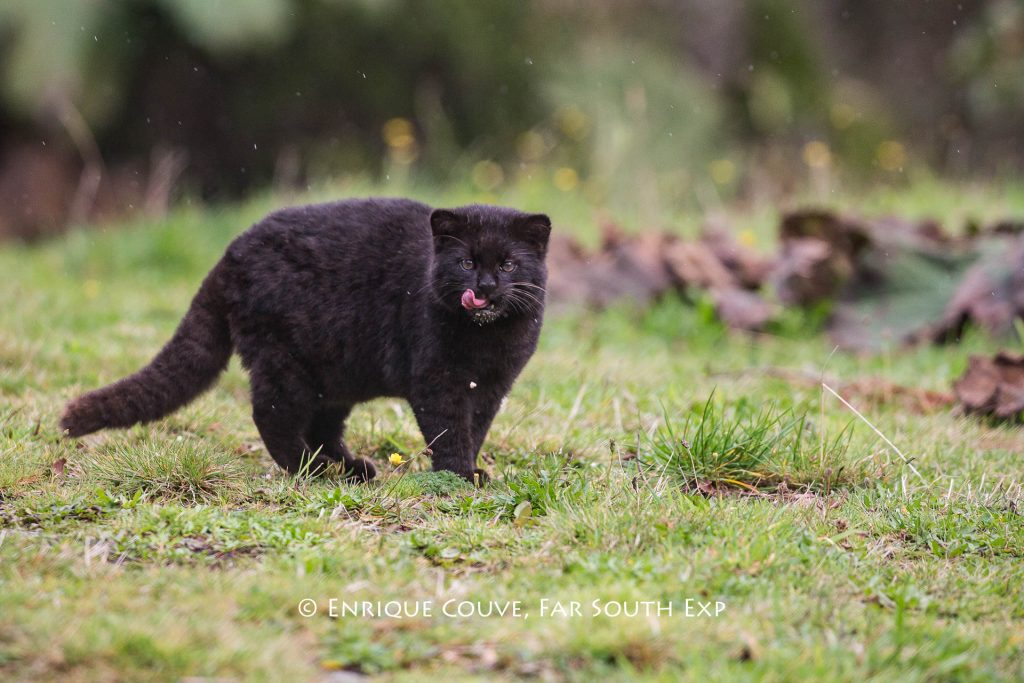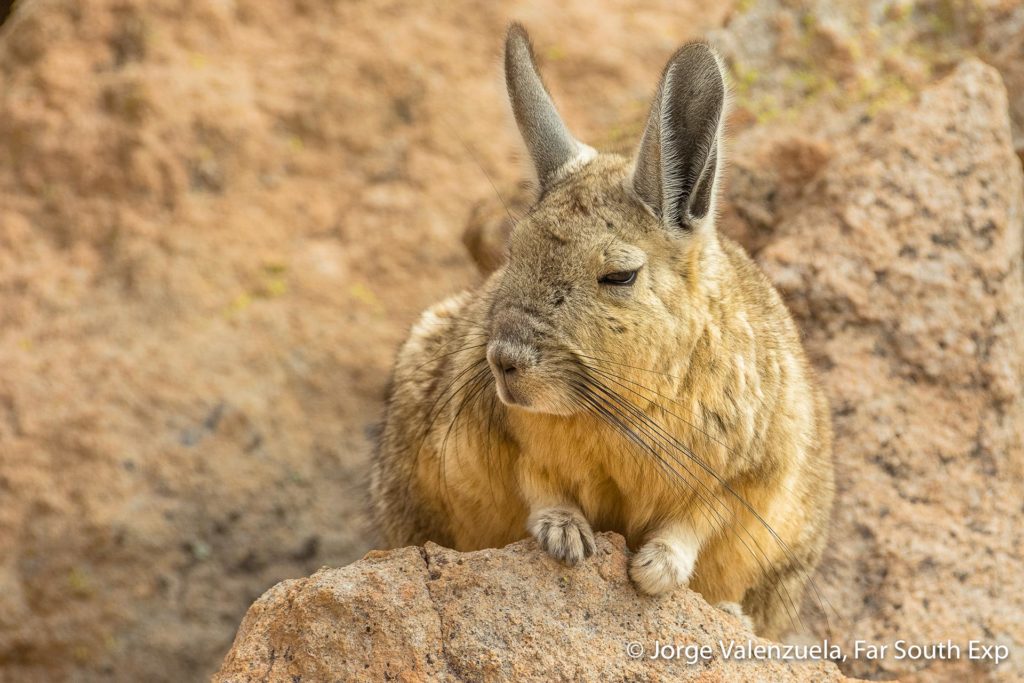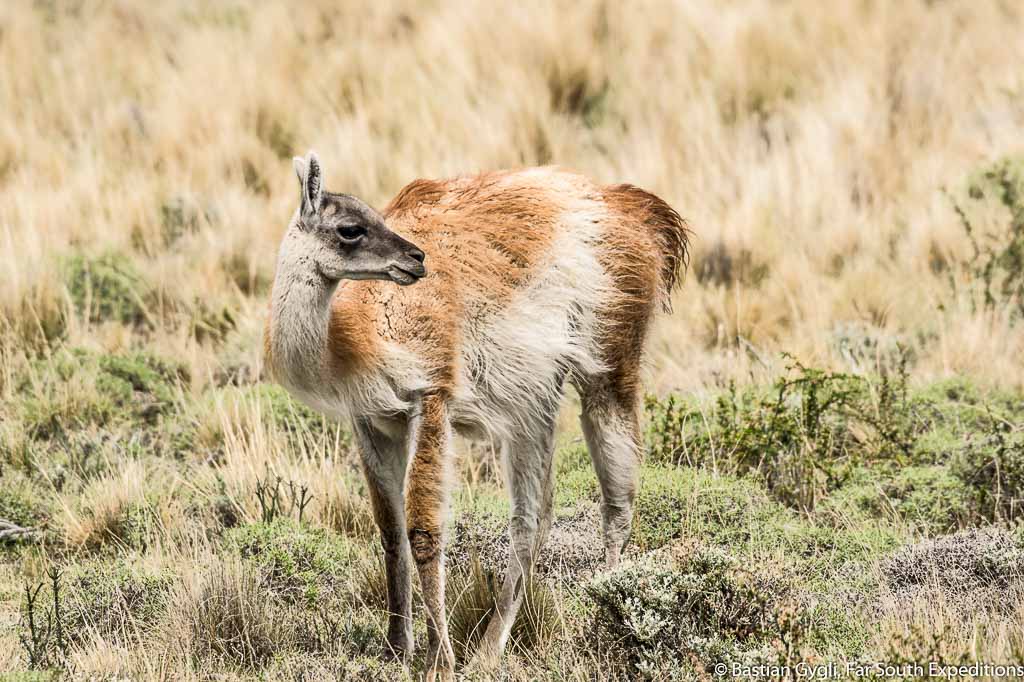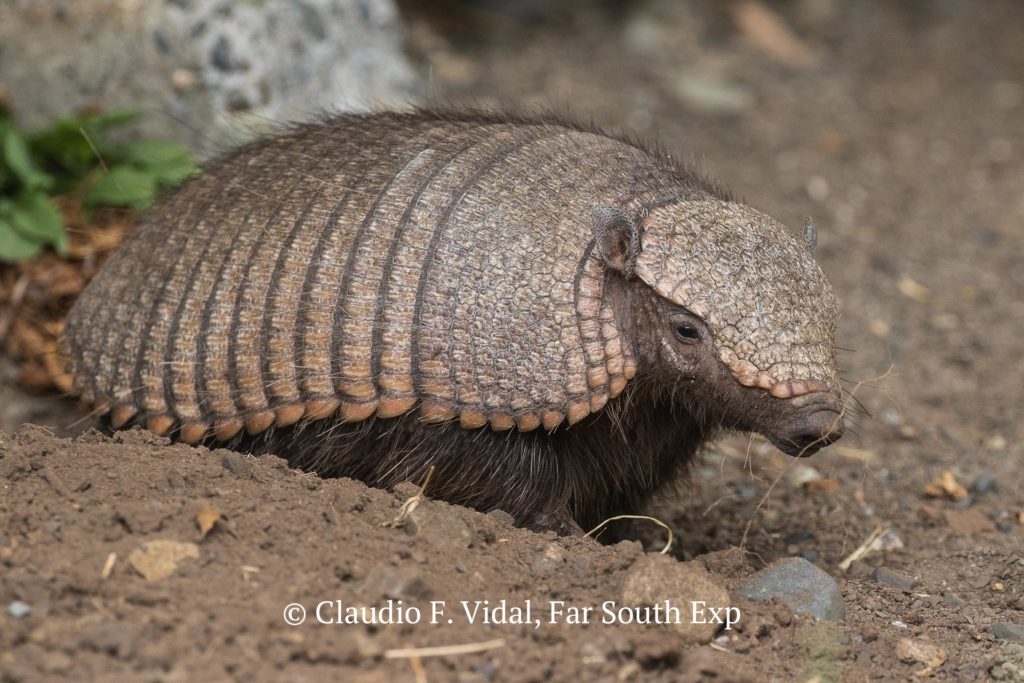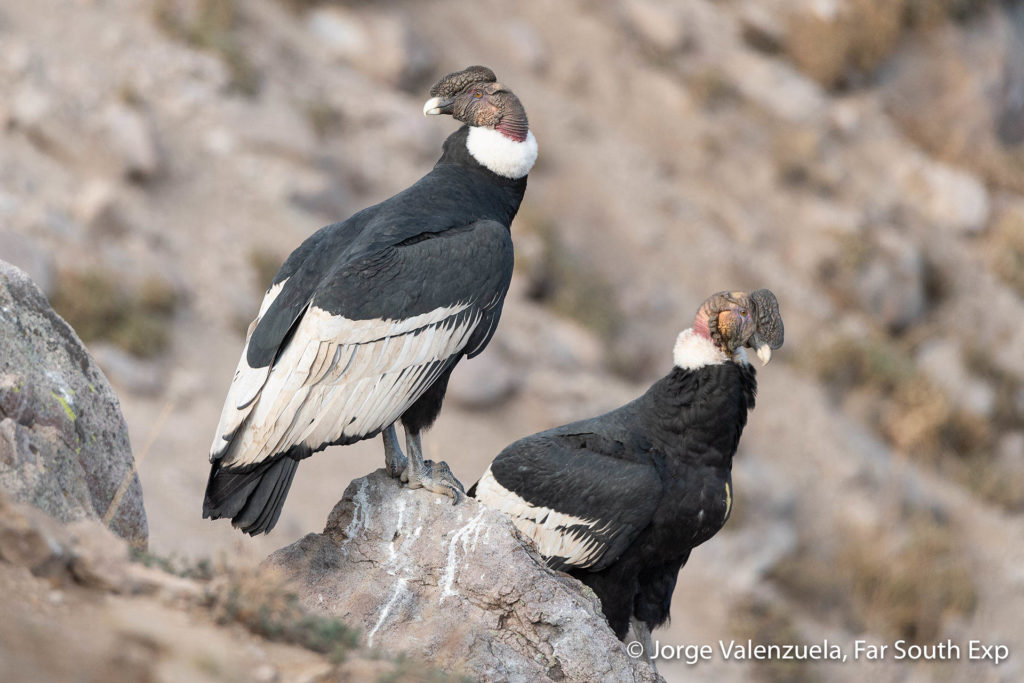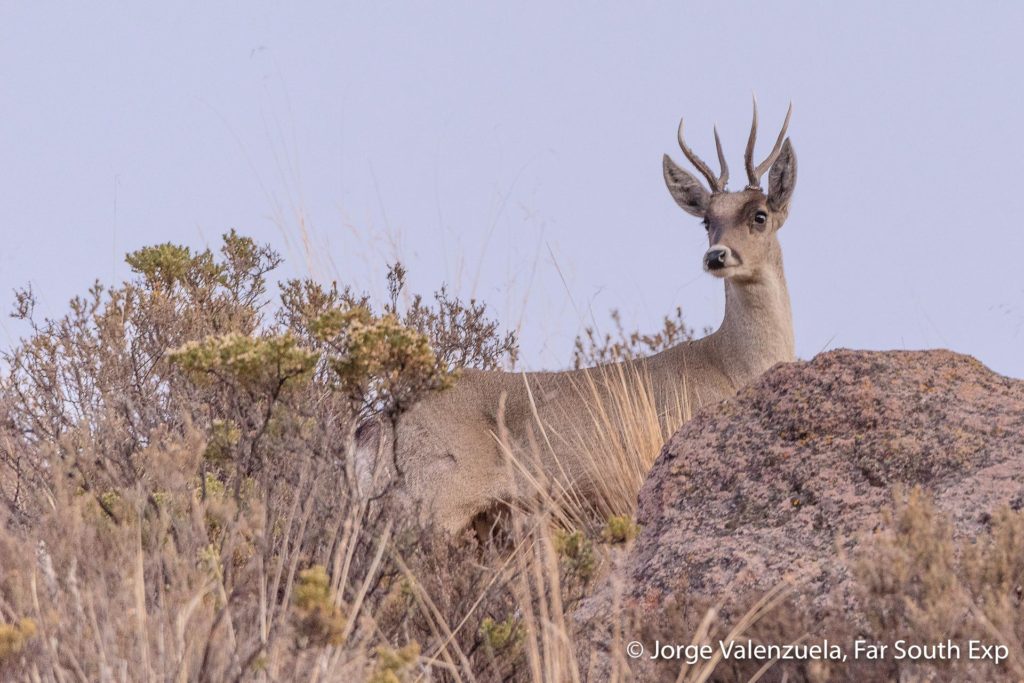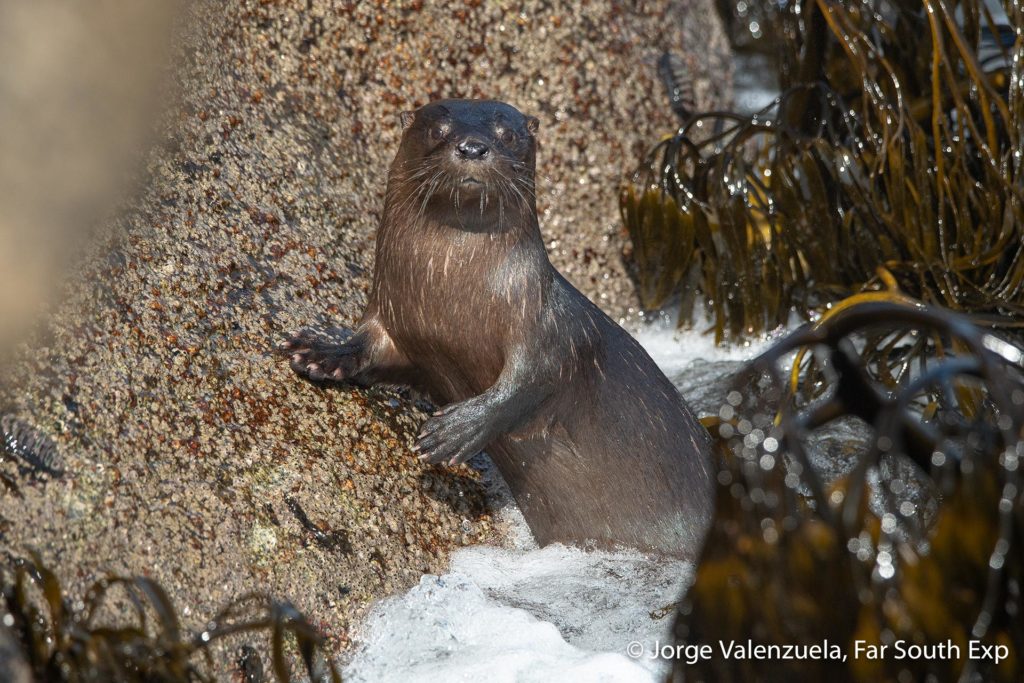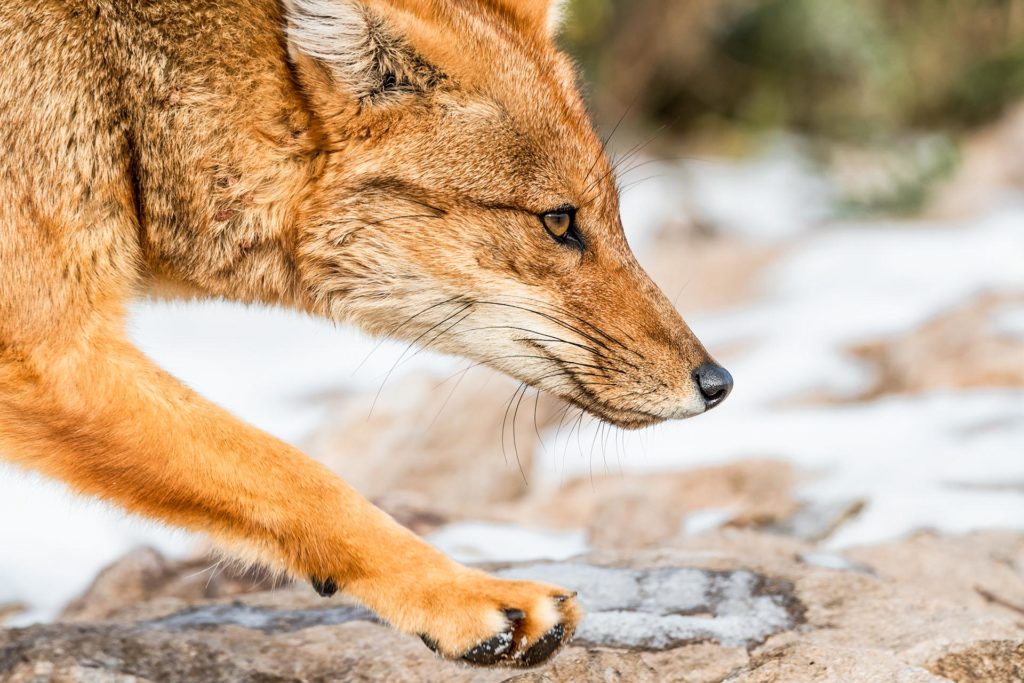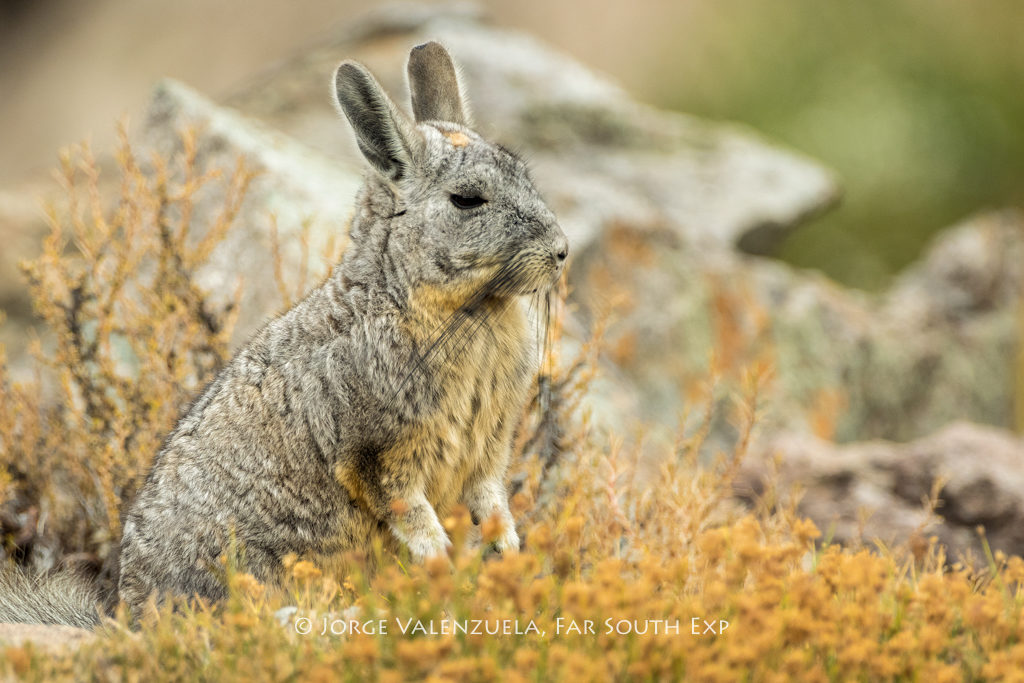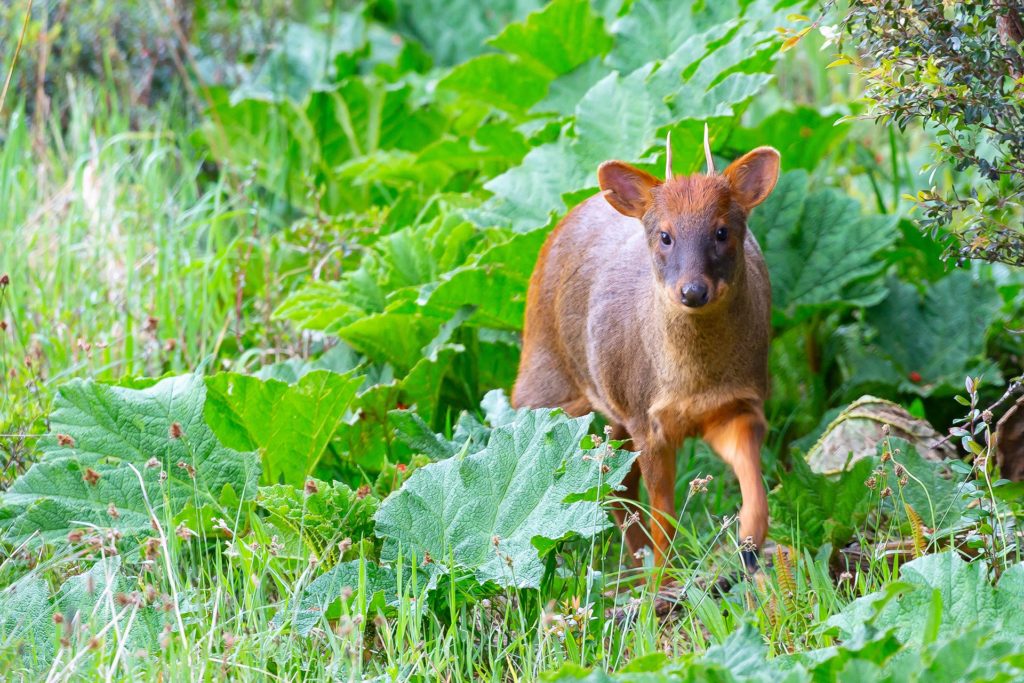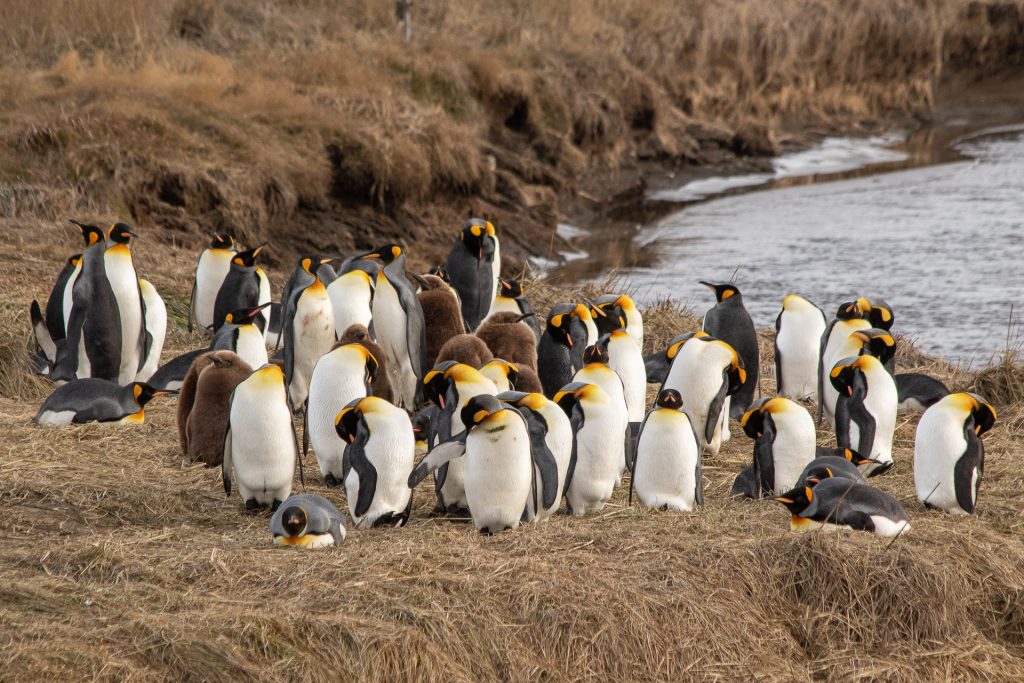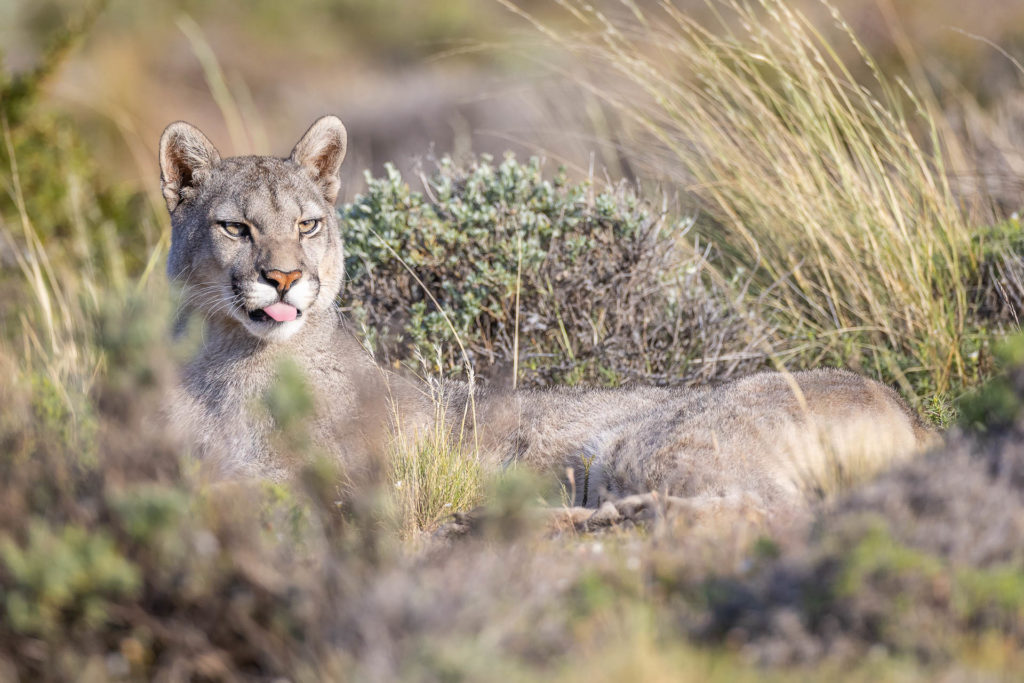On this trip you will discover the wildlife riches of this long and narrow country, extending along the west coast of South America. You will have the unique chance to explore the magnificent Andes and to see how these impressive mountains have molded contrasting habitats that will be evident as we move in latitude; from oasis valleys to puna bogs in the northern Andean plateau, from lakes, snow-capped volcanoes and lush rainforests to calving glaciers and wind-swept steppes in Patagonia. These varied ecosystems hold a unique set of wildlife and we will be privileged to observe an iconic array of animals; from guanacos and vicuñas to foxes and dolphins plus a great variety of birds ranging from the mighty Andean Condor to King Penguin. Chile wildlife trip
Chile's Best Wildlife |
Chile Wildlife Trip | The Ultimate Wildlife Adventure in a Thin Country
We will explore the world’s driest desert, the Atacama, and Lauca National Park, one of Chile’s gems. This impressive park is also a World Biosphere Reserve and teeming with wildlife in spite of the altitude. Further south, the land breaks into hundreds of islands and fjords. We will have a comprehensive exploration of Chile’s Lake District and the picturesque and diverse Chiloé Island. Finally Patagonia and Tierra del Fuego, a remote land crowned with granite peaks, colossal glaciers and mythic waterways, is home to penguins, cetaceans and the impressive Puma. Chile wildlife trip
2025 Departures |
November 3 to 21
2026 Departures |
November 2 to 20
19-day trip from Santiago de Chile
Min. 3 / Max. 6 participants
Click for space request |
Pudu Deer, Chiloé Island © Enrique Couve, Far South Expeditions
Itinerary in Brief |
Day 1 • Flight to Iquique (1 night)
Day 2 • Boat trip to Iquique harbour – Chaca & Camarones Valleys – Arica (1 night)
Day 3 • Azapa Valley – Drive to Putre (3 nights)
Day 4 • Parinacota & Lauca NP
Day 5 • Surire salt flat
Day 6 • Putre – Drive to Arica Airport – Flight to Puerto Montt – Puerto Varas (1 night)
Day 7 • Ferry to Chiloé Island – Boat trip off Puñihuil – Puñihuil (2 nights)
Day 8 • Boat trip off Chiloé Island – Caulin Bay
Day 9 • Boat trip Chepu River – Drive to Tepuhueico (2 nights)
Day 10 • Tepuhueico Park
Day 11 • Tepuhueico Park – Drive to Puerto Varas (1 night)
Day 12 • Flight to Punta Arenas – Magdalena Island (1 night)
Day 13 • Drive to Torres del Paine NP (3 nights)
Day 14 • Torres del Paine for pumas and other wildlife
Day 15 • Torres del Paine for pumas and other wildlife
Day 16 • Pali Aike NP – Drive to Porvenir (2 nights)
Day 17 • King penguins – Laguna de los Cisnes NR
Day 18 • Ferry to Punta Arenas – Condors of Rio Verde (1 night)
Day 19 • End of the trip chile wildlife trip
Trip Highlights |
• In-depth nature and photo journey to discover the wealth of wildlife and ecosystems found along Chile.
• Explore with us two of Chile’s biosphere reserves: Torres del Paine and Lauca National Parks.
• Visit penguin colonies of three different species: King, Magellanic and Humboldt penguins.
• An interesting array of mammals including Guanaco, Vicuña, Viscacha, two species of otters, foxes, deer, dolphins and sea lions.
• A great variety of charismatic birds, from Andean Condors to stunning Inca Terns.
• A huge variety of habitats including active volcanoes, Andean bogs, lush temperate rainforests, fjords, steppes and glaciers.
• A study of the rich cultural history (and pre-history) from the people of the High Andes to the natives of Patagonia and Tierra del Fuego.
• Ideal journey for nature enthusiasts and photographers. chile wildlife trip
Trip Maps |
Northern Chile |
Chiloé Island |
Southern Patagonia |
Detailed Itinerary and Activities |
Our wildlife adventure starts today! From Santiago you’ll take an afternoon flight to Iquique in the very north of Chile.
Night in Iquique (Lunch, Dinner)(Guide)
In the morning, we enjoy a navigation to Iquique harbor. We’re likely to see bird species such as Guanay cormorant, Peruvian pelican and the stunning Inca tern. This trip provides us an impression of the enormous productivity of the Humboldt current ecosystem. We marvel at immense flocks of marine birds and remarkable accumulations of marine mammals, living here in the area. In the afternoon, we will be driving along the Panamerican Highway and explore the interesting valley of Chaca where we expect to see other desert specialties including Tamarugo Conebill and the critically-endangered Chilean Woodstar.
Night in Arica (Breakfast, Lunch, Dinner)(Guide)
Today we’ll drive into the Azapa valley where we’ll visit the University Museum which holds an impressive collection of Chinchorro mummies, the oldest in the world. Later on we’ll explore the valley in search of a wealth of desert loving bird species such as Peruvian Sheartail and the odd-looking Slender-billed Finch. Azapa valley is renowned for being an olive growing country, and both its olives and olive oil are well known in Chile for their exceptional quality. This is also the place where we will visit a unique “hummingbird garden”, an orchard whose owner has turned it into a small home preserve into which up to four different species of hummingbirds can be found flying around, feeding on the flowers and sometimes nesting on the trees, providing with great photographic opportunities. These places are also remarkable for the presence of some giant geoglyphs that were left by the ancient natives in the slopes of hills dominating the valley. They date from at least 600-800 years BC and mostly depict scenes reflecting the semi-nomadic life of these ancient herders, like llama caravans, shepherds, birds and other wildlife and hunting scenes. We’ll then continue eastwards across the barren Atacama, the driest desert in the planet, towards the mountains. Andean Swifts and Grayish Miners are possible bird species just before we reach the hyper-arid desert stretch, as we drive up to the highlands, to reach the foothills of the Andes and the charming village of Putre. We will make a few stops along this interesting road, particularly to study closely the remarkable Chandelier cactus plus other desert vegetation growing in the barren hillsides. Close to Putre, we will find the old Inca fortress (or pukara) of Copaquilla, a complex of some 400 stone buildings defended by a double stone wall, dating from the XIIth century. The picturesque Andean town of Putre is located at 3,400 meters above sea level (11,483 ft); this Aymara village will be our base for the following three nights. The gardens, cultivated terraces, eucalyptus groves and rocky walls surrounding Putre are the perfect habitat for Sparkling Violetear and Andean Hillstar, Golden-billed Saltator and Blue-and-yellow Tanager are among the range of exciting birds that occur here. If we’re lucky we might spot the rare Northern Huemul Deer (or Taruca) and herds of Guanaco in the surrounding hills.
Night in Putre (Breakfast, Lunch, Dinner)(Guide) Chiles best wildlife
Today we will visit the breathtaking Chungara Lake, truly one of the highlights of the trip, but before reaching it we will stop by the tiny village of Parinacota. Parinacota means “Lake of the Flamingos”, and true to its name, the village is set among a group of lakes and ponds where these beautiful birds live. The hamlet dates from pre-Inca days but it is better known for its old adobe and clay church, a fine example of XVIIth century Andean Baroque. The Altiplano (or High Andean plateau) is truly a “mecca” for wildlife and we will have the whole day to discover its many secrets and stunning landscapes. Established to protect the highest lake in the world, Lauca National Park (and World Biosphere Reserve) supports a great diversity of puna specialties. All three flamingo species – Chilean, James’s and Andean flamingos are often found here. Chungara Lake will be the highest spot during our entire trip (4,500 meters / 14,763 ft) and is surrounded by awe-inspiring volcanoes; this is a magnificent place and probably one of the most beautiful vistas that we will have during our whole journey exploring Chile. The lake is full of birds including the striking Giant Coot and noisy Andean Gull. The surrounding bogs, locally known as bofedales, hold interesting mammals, all specialized to the high altitude, such as herds of Vicuña and charismatic Mountain Viscacha. The landscape of this area is dominated by the omnipresent and imposing Payachatas, meaning “The Twin Volcanoes”, the Pomerape, 6232m/20,446ft and the Parinacota, 6,110m/20,046ft, situated on the border with Bolivia.
Night in Putre (Breakfast, Lunch, Dinner)(Guide) chile wildlife trip
To see the Surire saltpan at sunrise is certainly one of the most fascinating sights of the whole Chilean Altiplano, as the lake holds one of the largest concentrations of the rare Puna Flamingo. Puna Rhea, Puna Tinamou, Chilean and Andean flamingos, Andean Lapwing and a large variety of waterfowl including Andean Goose, Puna Teal, Crested Duck and Speckled Teal are also found here. Surire is reached after a nearly 3-hour drive from Putre, so an early start is required to see the lake at dawn. We guarantee that you won’t be disappointed! This salt flat is really a must for birders, especially if you like flamingos, for it is one of the very few places in the world where you can find all three species of High Andean flamingos in the wild, including the rare, range-restricted and endangered Puna Flamingo. The critically endangered and even rarer Puna Rhea is also present in the area, and the lovely vizcachas living in the rocky outcrops just by the ranger’s hut will delight you with their tameness and funny antics. But it’s not only wildlife photographers that will be delighted, for this site offers superb landscape photography as well, with its salt flat, mountains and rock formations.
Night in Putre (Breakfast, Lunch, Dinner)(Guide)
Today we head back down to the coast, to Arica. This is Chile’s northernmost city and lies between the Pacific Ocean and the steep coast of the Atacama Desert at 18°S. Its shores and coastal valleys were the home of the Chinchorro culture, who mummified their dead already around 8,000 BC, pre-dating the Egyptians by several thousand years. From here we take a flight to Santiago and continue directly to Puerto Montt. The city of Puerto Montt is located 600+ miles south of Santiago and is the entrance to Chile’s Lake District. The topography south of here starts to break out, forming the maze of archipelagos and channels known as the Patagonian Fjords. We will be heading north this time and if is the skies are clear we will have the chance to admire a line of volcanos forming part of the southern section of the Andes; the most striking, no doubt, is Osorno and its almost perfect cone-shaped outlook. The grasslands and agricultural fields are very reminiscent to those in the English countryside and are ideal habitats for common birds such as Black-faced Ibis, Chimango Caracara, Southern Lapwing, Chilean Flicker, Rufous-tailed Plantcutter, Common Diuca Finch and Grassland Yellow Finch. Occasionally, noisy flocks of the endemic Slender-billed Parakeet are seen attending the fruit trees and orchards. Our base will be the delightful town of Puerto Varas, located along the shores of Llanquihue Lake.
Night in Puerto Varas (Breakfast, Lunch, Dinner)(Guide)
This morning we will drive southwards to the ferry across the Chacao Channel; this short 30-minute ride offers great marine wildlife viewing opportunities and is likely we can see pods of Peale’s Dolphin, groups of South American Sea Lion and a great array of seabirds including Southern Giant Petrel, Sooty and Pink-footed shearwaters, Imperial and Red-legged cormorants, Peruvian Pelican and South American Tern. Once on the island, we’ll take a scenic drive to the little fishermen’s cove of Puñihuil, where we’ll board a boat to the nearby islets that are home to several species of seabirds and marine waterfowl like Rock Cormorant, Kelp Goose and Flightless Steamer Duck, and especially, the only known mixed colony of both Humboldt and Magellanic penguins. Marine mammals like South American Sea Lion and Marine Otter are regulars here as well.
Night in Puñihuil (Breakfast, Lunch, Dinner)(Guide) chile wildlife trip
For the morning we will have arranged a special boat excursion towards the wild west coast of the island, facing the Pacific Ocean. This time we will spend more time at sea to have more opportunities for wildlife and aim to the impressive Metalqui Island. Pygmy Blue Whales, one of the races of the world’s largest living animal, are often seen from December until March. Humpback Whales are often spotted here as well. We also have other great pelagic prospects such as the poorly-known Subantarctic Shearwater, which probably nests in this rugged, densely forested coastline. Metalqui is well known to hold a very large breeding colony of South American Sea Lion. During the afternoon, we will visit the mudflats of Caulin Bay, an important stopover for flocks of migrating shorebirds which holds an important part of the world population of Hudsonian Godwit, a truly long-distance champion that winters here and in other extensive bays of Patagonia together with Red Knot and a variety of other shorebirds. Black-necked Swans are usually seen here at large numbers.
Night in Puñihuil (Breakfast, Lunch, Dinner)(Guide)
Early in the morning we will head exploring the rural communities of the northern part of the island. Our destination is the picturesque Chepu River, a scenic watercourse bordered by lush and dense forest and clear waters that are home to a critically endangered species, the Southern River Otter or Huillin, which we’ll attempt to see by taking a boat trip. The fairly large reed-fringed pond of Coluco is a also wonderful wetland habitat; we will enjoy here seeing large numbers of nesting waterbirds such as Black-necked Swan, Chiloe Wigeon, Cinnamon Teal, Red-gartered Coot, Brown-hooded Gull and Snowy-crowned Tern. We will also have chances to spot Coipo (a large rodent related to Capibaras), Osprey and passing flocks of the endemic Slender-billed Parakeet. Later we will drive to the magnificent Tepuhueico Park, a private reserve where we will spend the next couple of days exploring the lush Valdivian humid forest, looking for stunning wildlife. Mammals like Pudu Deer, and several frogs and lizards that live among moss and fern-covered tree trunks of these dense, lush woods, provide excellent chances for both wildlife and macro photography, as the miniature forests of lichens, fungi and mosses are home to a whole world of insects, amphibians and other tiny creatures living on the damp soil and old, fallen trees.
Night in Tepuhueico (Breakfast, Lunch, Dinner)(Guide)
Early in the morning we will start exploring the imposing Tepuhueico, a private reserve where we’ll spend the whole day looking for wildlife. The pristine Tepuhueico woodlands are part of the unique ecosystem known as Valdivian Temperate Rainforest. Tepuhueico has the reputation of being a highly reliable place to see the critically endangered Chilean endemic Darwin’s Fox. A few hundred individuals of this fox survive in the ecotone between the dense temperate forests and the coast. We will have interesting walks in search of Darwin’s Fox, Pudu Deer (the second smallest deer in the world) and the Kodkod or Guigna (a very rare woodland cat). While searching for this array of enigmatic and poorly known mammals, we find several endemic birds of the Patagonian woodlands such as Black-throated Huet-huet, Chucao, Ochre-flanked and Magellanic tapaculos, Patagonian Tyrant, Des Murs Wiretail, Chilean Pigeon, Magellanic Woodpecker, Chilean Hawk and Green-backed Firecrown.
Night in Tepuhueico (Breakfast, Lunch, Dinner)(Guide)
We will spend most of the morning exploring Tepuhueico. Later we will drive east to reach the picturesque towns in the protected eastern coast. Here we will concentrate in studying the cultural features including the famous stilt houses set right on the muddy shores and the wooden churches of the surroundings. During the afternoon we will visit up to three churches, all representatives of the colonial wooden construction whose architecture was inspired by shipbuilding, a skill most old-time islanders mastered. The churches we will potentially visit include those located at Dalcahue, Castro and Nercón. These wooden remarkable temples are regarded as World Heritage Sites and represent the legacy of the Jesuit missionaries who explored these intricate archipelagos in the XVII and XVIII centuries.
Night in Tepuhueico (Breakfast, Lunch, Dinner)(Guide)
After meeting your guide at Punta Arenas, we will sail out bound for Magdalena Island, in the waters of the mythical Straits of Magellan, in Patagonia. This protected area holds a remarkable Magellanic Penguin colony of more than 28,000 individuals. Besides the penguins, several other species of seabirds such as Imperial & Rock Cormorants, Dolphin and Kelp Gulls, Chilean Skua and South American Tern nest here. In the early afternoon we will be reaching Magdalena Island and its imposing cliffs, teeming with wildlife. We will have one hour to explore the trail towards the center of the island, which ends at the conspicuous lighthouse which is now the ranger station. We will be overwhelmed by the large numbers of penguins inhabiting every available spot of the island’s surface and by their raucous braying calls. Some of the penguins will be busy while landing, coming ashore from their feeding trips, taking a bath or preening and resting peacefully at the shoreline while others will be waking with its characteristic gait towards their burrows to incubate the eggs or attend their chicks. Several other seabird species breed in the island including Imperial and Rock Cormorants, Dolphin and Kelp Gulls, Chilean Skua and South American Tern. South American Sea Lions occasionally patrol the coast looking opportunities to catch a distracted penguin.
Night in Punta Arenas (Breakfast, Lunch, Dinner)(Guide)
From here you will be transferred to Torres del Paine National Park. During our journey to the park, we might find Guanaco, Southern Grey Fox, and Patagonian Skunk, while enjoying our first contact with Southern Beech (Nothofagus) forests. While visiting the valleys we will be given a geological interpretation of the origins of the dramatic backdrop of Torres del Paine, one of the finest natural spectacles in Patagonia.
Night in Torres del Paine area (Breakfast, Lunch, Dinner)(Guide)
We have planned a busy day and night schedule in search of Puma in the area. We will inspect the immediate surroundings of our hotel at night as well as the puma hunting grounds located in the eastern part of the park. The area between the northern coast of Sarmiento Lake, Laguna Amarga and Laguna Azul, is known for holding one of the largest concentrations of puma in the wild. February through April is a particularly good period to look for them, as the females are actively hunting to provide food to their growing cubs; at this time they are not active just by night but also in the twilight. To see a female puma and its large-sized cubs against this magnificent mountain backdrop and dramatic skies is one of the most impressive sights in this wilderness. In company of our guide and puma tracker we will follow puma family groups and watch them from a safe distance with the help of binoculars and spotting scopes. We’ll also look for other mammals around, including the ubiquitous Guanaco, Andean or Huemul Deer, Patagonian Hog-nosed Skunk and the two foxes present in the park, Chilla and Culpeo.
Night in Torres del Paine area (Breakfast, Lunch, Dinner)(Guide) chile wildlife trip
This morning we will explore the ponds on the eastern side of the park in search of more waterfowl, including Spectacled Duck, Chiloe Wigeon, Speckled Teal, Yellow-billed Pintail and Crested Duck among others. Black-necked Swan and Great Grebe are also found here. Cinereous Harrier and Black-chested Buzzard-Eagle are often seen hovering in search of prey. Chilean Flicker, Striped Woodpecker and Austral Pygmy Owl will be our targets around a patch of secondary woodland. We will scan the white water rivers for the remarkable Torrent Duck. In the eastern side of the park, we’ll find groups of the southernmost representative of the camel family, the charismatic Guanaco. The reed-fringed lagoons can be very interesting: Andean Duck, Silvery and White-tufted grebes, and with luck the elusive and recently re-discovered Austral Rail, are all present here. We will visit Lake Grey to enjoy the dramatic sight of its southern shore dominated by stunning blue icebergs, and the surrounding sub-Antarctic forests will provide with chances to see Thorn-tailed Rayadito, White-throated Treerunner, Austral Parakeet, Austral Blackbird and the striking Magellanic Woodpecker.
Night in Torres del Paine area (Breakfast, Lunch, Dinner)(Guide) chile wildlife trip
We will leave Remota and Puerto Natales, hopefully with many rewarding memories of our explorations and wildlife encounters on this beautiful corner of Patagonia. We will drive eastwards across the vast wind-swept steppes and along the border with Argentina, which here is literally a straight, seemingly endless line. Pali Aike National Park and its many extinct cinder cones mark a place that break this uniform, big-sky country. The area was extensively occupied by long-gone Indians, and it has a very rich archaeology and paleontology. The birdlife of the area is very interesting too, as we may find intriguing species such as the Least Seedsnipe, Tawny-throated Dotterel, Chocolate-vented Tyrant and the colorful Black-throated Finch.
We will take a short ferry ride across the narrowest portion of the Magellan Straits, where we expect to see the delightful and local Commerson’s Dolphin. ‘Tierra del Fuego’, the ‘Land of Fire’ is another landmark coined by the skilled navigator Ferdinand Magellan. In 1520, while crossing the seaways that now honor him, he and his crew spotted a line of bonfires along the coast of a huge landmass. Tierra del Fuego is now a land of endless wind-swept steppes, rolling hills and lush temperate forests; sheep-farming stations, locally known as ‘estancias’, are interspersed amidst these picturesque and colorful landscapes dominated by dramatic skies. We will continue our journey towards the small village of Porvenir.
Night in Porvenir (Breakfast, Lunch, Dinner)(Guide) chile wildlife trip
We will be driving for approximately two hours along the shores of Bahia Inutil (Useless Bay), where we expect to see a great array of wildlife including Guanaco, Southern Grey Fox, the ubiquitous Upland Goose, Chilean Flamingo and a diversity of waterfowl. At sea we may see albatrosses, petrels, gulls and skuas patrolling the turbulent waters of the bay. Parque Pingüino Rey is a private nature reserve that aims to preserve the only known continental King Penguin colony. We will have ample opportunities to observe and photograph the penguins from a reasonable distance (maximum approach distance will be given by the guide and must be respected at all times during your visit).
Night in Porvenir (Breakfast, Lunch, Dinner)(Guide)
We will enjoy a leisure morning while exploring the surroundings of Porvenir to photograph and learn about the particular wildlife and history of this remote corner of Patagonia. We will visit its alkaline pools where there are large aggregations of migratory birds such as sandpipers and plovers, but the goal will be to photograph Chilean Flamingos. Later we will explore the coast to see some of the many shipwrecks that have occurred in these seas over the years. After lunch we will be heading back to Punta Arenas by ferry. By taking the short ferry at Punta Delgada we will have great chances of seeing the striking Commerson’s Dolphin plus other interesting wildlife.
Olga Teresa Ranch features the most accessible location in the world to see and photograph the world’s heaviest flying creature: the famous and majestic Andean Condor. Reachable by car in only 60-70 minutes from Punta Arenas, Chile, the ranch protects, researches, and showcases a population of 100 Andean Condors that soar, socialize, and sleep at a 20-meter-tall, vertical rock face that itself is embedded in a steep, 200-meter-high (700-foot-high) hill. This condor spectacle is available at any time of day, but the best condor viewing generally is from 1500h to sunset.
Night in Punta Arenas (Breakfast, Lunch, Dinner)(Guide)chile wildlife trip
The trip ends after breakfast with a complimentary transfer to the airport. chile wildlife trip
Dates & Rates |
Scheduled trips
Trip Length | 19 days, 18 nights |
|
Dates | 2025 | November 3 - 21 |
2026 | November 2 - 20 |
|
Price per person (USD) | $13,550 |
|
Single Supplement (USD) | $1,360 |
|
Trips are guaranteed to depart with a minimum of 3 participants. Maximum group size of 6 participants. |
||
The above prices are per person in US Dollars, based on double occupancy.
All payments are in US Dollars.
Single supplement will be added if single accommodations are requested. chile wildlife trip
What the trip includes / excludes
The trip price includes: All accommodations, meals and guide services as stated in the itinerary, private ground transportation during the tour, two ferry rides, and park entrance fees. A daily bottle of mineral water is also included.
The trip price excludes: Domestic flights, tipping for restaurants and guides, travel insurance, entrance tax to Chile, excess baggage charges, à la carte dishes, snacks, drinks, laundry, telephone calls and anything else of a purely personal nature. chile wildlife trip
Download Wildlife Checklist |
Tour Registration |
To book this tour, please fill in our online registration form. We will process your booking and will send you a note with space confirmation and a transfer invoice with payment instructions within 24 hours. The transfer amount is 500 USD per person. Full payment of the tour fee is due 90 days prior to tour departure.
NOTE: Inquiries received on Saturdays, Sundays and Holidays will be replied to during the following working day.
Cancellation Policy
Notice of cancellation can only be accepted in writing from the person who signed the booking form and takes effect on the day such noticed is received by us.
Refunds are made according to the following schedule:
• If cancellation is made 120 days or more before departure date, the transfer amount minus 200 USD is refundable.
• If cancellation is made between 120 and 60 days before departure, the transfer is not refundable, but any payments covering the balance of the fee will be refunded.
• If cancellation is made less than 60 days before departure date, no refund is available.
This policy and fee schedule also applies to pre-trip and post trip extensions, as well as any transfers from one tour to another. We strongly recommend the purchase of trip cancellation insurance to protect yourself.

